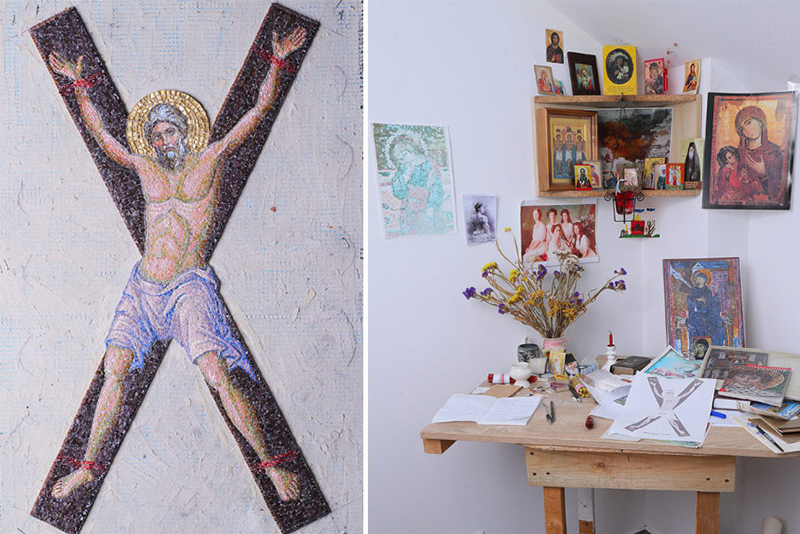
In the ancient city of Patras, Greece, its main attraction is the cathedral that keeps the relics of the Holy Apostle Andrew the First-Called. Here, in the year 66 AD, he died a martyr’s death on the cross on orders from the authorities of the Roman Empire. But what does this faraway city have in common with Saint Elisabeth Convent? We put this question to Brother Dmitry Kuntsevich from the mosaics workshop. He told us this story.
A surprise request
Our workshop has a page on Facebook, where we post photos of our works for our friends and all others who might take an interest in them, appreciate their value, find out more about us, or maybe even come to learn our techniques. Our daily prayers and our supplications for the grace of the Holy Spirit have been conducive to our successes, which we like to share with other people. The fruits of His intercession, we hope, will become an inspiration to some.
Monk Nicholas from Dionysiou Monastery on Mount Athos stumbled across our page on the Internet. An author of the project idea for Patras and likely an artist himself, he was interested in our works. By all signs, he was a person who developed design solutions for reliquaries and relics. He told us about an ongoing effort at the Cathedral in Patras to renew the icing frame of the cross of Saint Andrew the First-Called.
We did not meet monk Nicholas in person but assumed that he may have inspected our works on Mount Athos and proposed to adorn the reliquary in Patras with a mosaic depicting the Apostle in the centre of the cross and suggested our workshop as a candidate to do the work. As he had explained, the idea was to superimpose a silver frame on the original cross and to place in relief sculptures of ivory, a common material in the Byzantine art tradition. Our mosaic of Saint Andrew on the cross would be placed in the middle of the relic. It would be a small-sized work of up to fifty centimetres of height, and the face of Saint Andrew would be no more than a few centimetres across. The mosaic would be made of small pieces of smalt of several millimetres and affixed to the surface with mineral glue.
Sasha, the little angel of God
Because we specialise more in monumental art, we were not used to this technique and had some difficulty with it.
Sister Inna Korney assembled the mosaic, and she is one of our best workers. She has been a member of the sisterhood for many years. She is pious, god-fearing and passionate about her work. As an artist, she has remarkable intuition and a sense of spiritual connectedness to God and Saint Andrew. She strives for excellence and is deeply worried when the work is not progressing as it should. She dedicates her whole heart to her work, praying and hoping for God’s help throughout the project. Her prayerful connection with the Lord impacts her work and helps her create mosaics, panel pictures and faces of the saints of exceptional beauty.
She completed the image of Apostle Andrew on the day that was special to her, connected with the memory of John the Forerunner. She completed one of her last mosaics, the Crucifixion of the Saviour, on the day of the beheading of John the Forerunner. It was for a client from Zhytomyr and had taken a lot of painstaking work in a style that imitated the academic painting tradition of the 19th century. The cross was so beautiful that the artists from the workshop had a hard time parting with it. As for the mosaic of the Crucifixion of Saint Andrew, Inna completed it on the day of the discovery of the head of John the Forerunner.
Not surprisingly, she had a helper, like many icon-painters of old. She called her her angel from God. When the workshop leader asked her about her progress, Inna would reply,
“Could be faster, but my angel is not here yet.”
When she is around, she surprises Inna with her exceptional sense of humour and her ability to encourage.
Inna recalls, “When I say to her, ‘I cannot go on. I am too tired, and she replies, “Wipe your tears, Inna, do not fret!
I say to her, ‘I do not know what to do next. I am stuck!’ She replies, ‘put your brain to work! Start thinking.’”
The angel’s name is Sasha, and she is the little daughter of one of the artists. Sasha always keeps watch over Inna, and she gives her a cosy space where she for her drawing, modelling and other creative projects. Sasha gives Inna her inspiration, and sometimes even amends her work in her absence. Some of her adjustments can take hours to undo.
Working at church is always a collaboration between man and God. God sends His angels to help, and no good work is possible without their intervention. By taking upon Himself most of the work, God’s relieves the artist from an unbearable burden, sometimes leaving him to complete the finishing touches. Yet even this small portion of the work can prove excruciatingly difficult, leaving the artist stuck and uncertain how to proceed. The artist is keen to produce a masterpiece and become a witness to God’s action but is left to deal with the imperfect work of his hands. The most important thing is to persevere with the work, and the moment of success finally comes. Creating a masterpiece is full of expectancies, much like our lives!
Recorded by Nun Olga (Velikaya)
Translated by The Catalogue of Good Deeds




